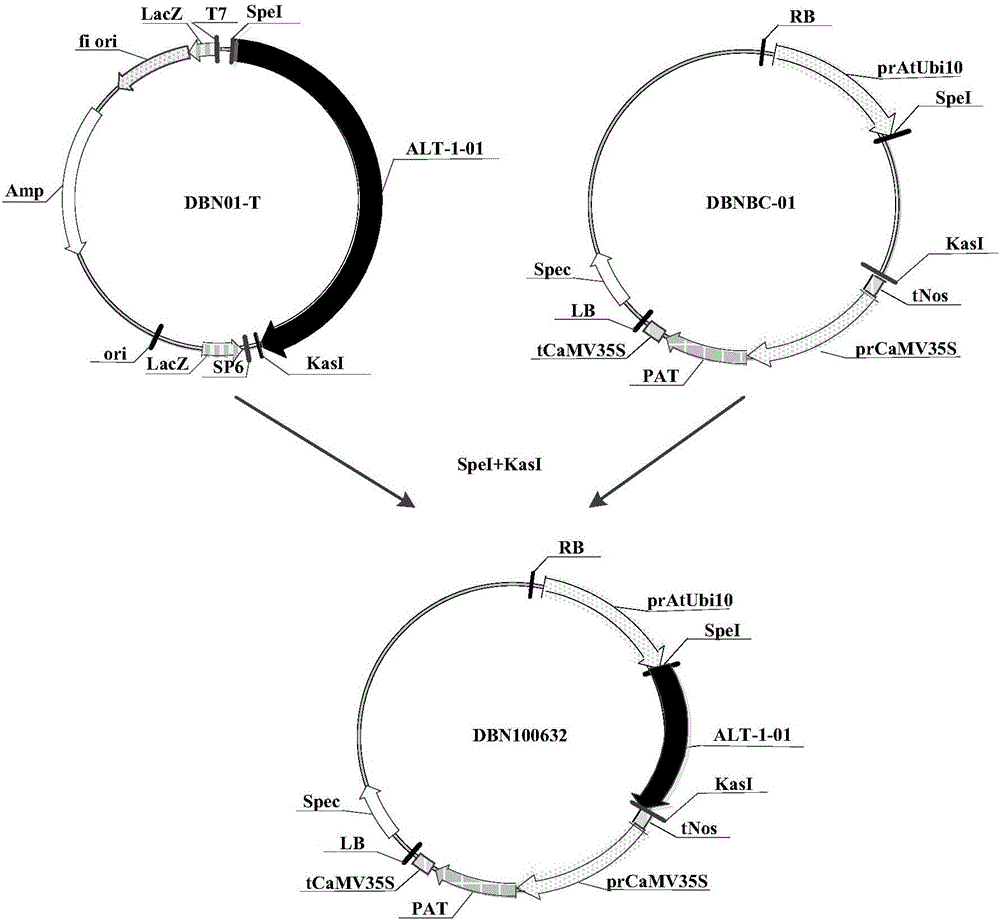Application of herbicide tolerance protein
A herbicide and protein technology, applied in the field of degrading pyrazosulfuron-methyl herbicide by thifensulfuron-methyl hydrolase
- Summary
- Abstract
- Description
- Claims
- Application Information
AI Technical Summary
Problems solved by technology
Method used
Image
Examples
no. 1 example
[0149] The first embodiment, the acquisition and synthesis of ALT gene sequence
[0150] 1. Obtain the ALT gene sequence
[0151] The amino acid sequence (398 amino acids) of thifensulfuron hydrolase-1 (ALT-1), as shown in SEQ ID NO: 1 in the sequence listing; ALT-1-01 nucleoside encoding the amino acid sequence corresponding to said ALT-1 Acid sequence (1197 nucleotides), as shown in SEQIDNO: 2 in the sequence listing, encoding is corresponding to the ALT-1-02 nucleotide sequence (1197 nucleotides) of the amino acid sequence of said ALT-1, such as Shown in SEQ ID NO:3 in the sequence listing.
[0152] The amino acid sequence (369 amino acids) of thifensulfuron hydrolase-2 (ALT-2), as shown in SEQ ID NO: 4 in the sequence listing; ALT-2-01 nucleoside encoding the amino acid sequence corresponding to said ALT-2 Acid sequence (1110 nucleotides), as shown in SEQIDNO:5 in the sequence listing, encodes the ALT-2-02 nucleotide sequence (1110 nucleotides) corresponding to the amino...
no. 2 example
[0158] The second embodiment, construction of Arabidopsis recombinant expression vector
[0159] 1. Construction of Arabidopsis and soybean recombinant cloning vectors containing ALT nucleotide sequences
[0160] The synthetic ALT-1-01 nucleotide sequence was connected to the cloning vector pGEM-T (Promega, Madison, USA, CAT: A3600), and the operation steps were carried out according to the instructions of the pGEM-T vector produced by Promega Company to obtain the recombinant cloning vector DBN01 -T, its construction process is as follows figure 1 Shown (wherein, Amp represents the ampicillin resistance gene; f1 represents the replication origin of phage f1; LacZ is the LacZ initiation codon; SP6 is the SP6 RNA polymerase promoter; T7 is the T7 RNA polymerase promoter; ALT-1-01 is the ALT-1-01 nucleotide sequence (SEQ ID NO: 2); MCS is the multiple cloning site).
[0161] Then, the recombinant cloning vector DBN01-T was transformed into Escherichia coli T1 competent cells (...
no. 3 example
[0174] The third embodiment, the acquisition of Arabidopsis plants transferred to the ALT nucleotide sequence
[0175] 1. Transformation of recombinant expression vector into Agrobacterium
[0176] Transform the correctly constructed recombinant expression vectors DBN100632, DBN100631, DBN100634, DBN100633, DBN100636 and DBN100635 into Agrobacterium GV3101 with liquid nitrogen method, and the transformation conditions are: 100 μL Agrobacterium GV3101, 3 μL plasmid DNA (recombinant expression vector); Place in liquid nitrogen for 10 minutes, and bathe in warm water at 37°C for 10 minutes; inoculate the transformed Agrobacterium GV3101 in LB test tubes and cultivate for 2 hours at a temperature of 28°C and a rotation speed of 200rpm, and apply it to 50mg / L rifampicin Ping (Rifampicin) and 50mg / L spectinomycin LB plates until a positive single clone grows, pick the single clone culture and extract its plasmid, and carry out enzyme digestion verification with restriction endonucle...
PUM
 Login to View More
Login to View More Abstract
Description
Claims
Application Information
 Login to View More
Login to View More - R&D
- Intellectual Property
- Life Sciences
- Materials
- Tech Scout
- Unparalleled Data Quality
- Higher Quality Content
- 60% Fewer Hallucinations
Browse by: Latest US Patents, China's latest patents, Technical Efficacy Thesaurus, Application Domain, Technology Topic, Popular Technical Reports.
© 2025 PatSnap. All rights reserved.Legal|Privacy policy|Modern Slavery Act Transparency Statement|Sitemap|About US| Contact US: help@patsnap.com



